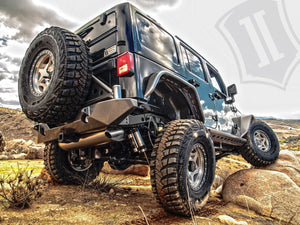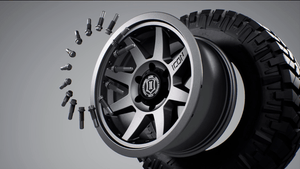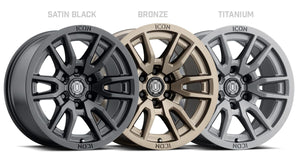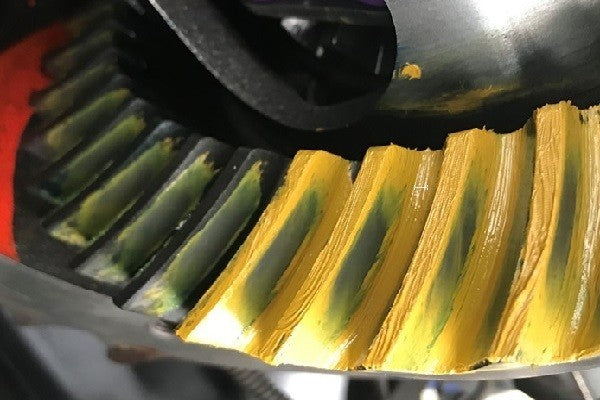
How To Create & Read Ring Gear Patterns
Gear tooth patterns are harbingers… they can foretell whether your ring and pinion gear set is going to live a long and prosperous life or if it’s doomed to an impending catastrophic failure. Pulling off a proper differential setup comes down to precise adjustments. Parameters like pinion depth, backlash, pinion-bearing preload, and carrier-bearing preload allow you to fine tune the relationship between gear teeth to ensure proper meshing and ultimate durability. Checking the Pattern We can determine how gears mesh by changing how close the pinion gear is to the ring gear centerline. While we can’t physically see how the gears actually relate to each other, we can coat their mating surfaces with gear-marking compound and read the patterns the gears create as they mesh. Genuine gear-marking compound offers a clear indication of gear contact without running or smearing. Anything other than gear marking compound (such as blue machinist dye) will not give a clear indication of tooth contact. Dilute the marking compound with a small amount of oil if necessary to create a smooth, but not runny, paste. Coat three or four ring-gear teeth in at least two places with a moderate amount of compound and rotate the ring gear around the pinion gear four or five times in both directions. Rotate by grabbing and turning the ring gear, not the pinion. Pinion resistance against the rotating ring gear helps establish a good pattern. Pinion bearing preload usually provides enough resistance for a good pattern, but additional resistance can be added by wrapping a shop towel around the yoke and pulling the two ends tight. An alternative method for checking gear patterns in cases where reading the pattern is difficult involves spinning the pinion. Paint three or four ring gear teeth as usual on both coast and drive sides of the teeth. Using a ½” drive adapter on a hand drill (not on an impact gun/driver) spin the pinion for 30 to 60 seconds in each direction while applying drag to the edge of the ring gear. Not only does this typically produce a clear, well defined pattern on the painted teeth, but it creates a negative or “ghost” pattern on the non-painted teeth that may provide additional insight to the pattern, while also conveniently showing any potential run out issues (where the pattern is shifting from heel to toe as the gear is rotated). This technique also helps to minimize diagonal striping in the pattern that occurs when rocking the gears back and forth, which can lead to misdiagnosed patterns. The down side of this method is more cleanup between adjustments to remove the compound but the additional data is well worth the effort. Here is a good example of the alternate technique. You can see on the bottom couple of teeth that were painted how the compound got smeared resulting in diagonal striping, and hard to read, as opposed to the “ghost” or negative patterns on the non-painted teeth being quite clear and well defined. Anatomy Of A Gear Tooth The pattern’s position to the tooth face (ridge/top land) and flank (valley/root) indicates pinion depth. Disregard the pattern’s position to the tooth’s heel (ring gear outside diameter) or toe (ring gear inside diameter). Gear patterns change from heel to toe, but in most cases an ideal heel-to-toe pattern is impossible to achieve. Furthermore, the housing itself influences the heel-to-toe pattern and the pattern cannot be changed without machine work. Trying to obtain a pattern centered exactly between the heel and toe usually leads to frustration and a noisy gear set if the face to flank pattern is not correct. Instead, concentrate only on the position of the pattern and how it relates from face to flank of the ring gear teeth. Cause, Effect, Action A contact pattern centered from face to flank indicates the correct pinion depth. A contact pattern closer to the gear face means the pinion is too far away from the ring gear. To correct the pattern, move the pinion toward the ring gear centerline. A contact pattern closer to the gear flank means the pinion is too close to the ring gear. To correct the pattern, move the pinion away from the ring gear centerline. How To Maneuver Your Pinion Pattern 1. Use shims to move the ring gear closer to the pinion gear to decrease backlash. 2. Use shims to move the ring gear farther from the pinion gear to increase backlash. 3. Use shims to move the pinion closer to the ring gear to move the drive pattern deeper on the tooth (flank contact) and slightly toward the toe. The coast pattern will move deeper on the tooth and slightly toward the heel. 4. Use shims to move the pinion further away from the ring gear to move the drive pattern toward the top of the tooth (face) and slightly toward the heel. The coast pattern will move toward the top of the tooth and slightly toward the toe. Make Large Pinion Depth Adjustments First When changing the pinion depth, make large changes until the pattern is close to ideal. Consider 0.005” to 0.015” a large change and 0.002” to 0.004” a small change. Intentionally, make adjustments that move the pinion too far at first. If the pinion moves too far and the pattern changes from one extreme to the other, the correct pattern lies somewhere between the two adjustments. Once you get close to the correct pinion depth, make smaller changes until the pattern centers between the face and the flank of the ring gear teeth. Once the backlash and pinion depth meet tolerances, remove the carrier and establish the final pinion bearing preload. Properly setting your ring and pinion gear is an important part of the drivetrain experience. Getting it right is the difference between decades of easy miles and a flurry of headaches and chunked-out gears after only a few miles. Shop Re-Gear Kits
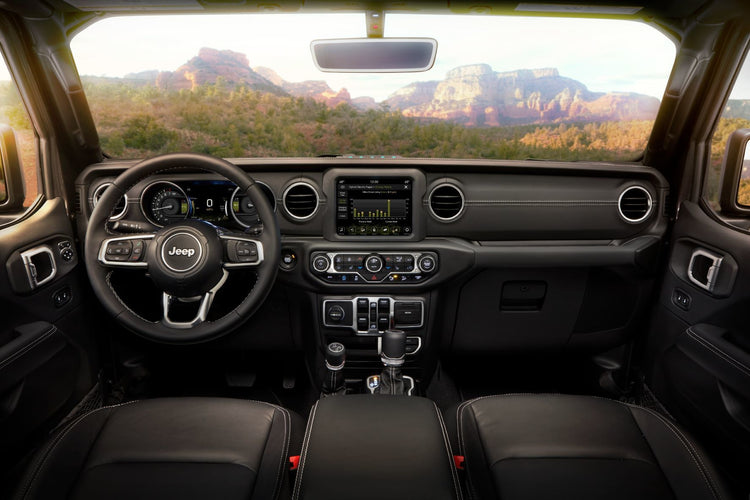
Gorilla Glass Windshields For Select Jeeps
Wrangler’s get beat on. We know this all too well as most of our products help zealous owners push the limits of their rigs to the extreme. Yukon Gear & Axle fortifies drivelines with chromoly axles, lockers and limited slips, and protects them with Hardcore Diff Covers. Jeep® Performance Parts (JPP) by Mopar has a fine line of protection parts including off-road bumpers, side steps/nerf bars, and winch kits. We were particularly impressed with Mopar’s line of Gorilla Glass replacement windshield offerings. The super strong windshield line was recently expanded to include the latest Jeep Wrangler and Jeep Gladiator models. From Jeep’s press release: “The new JPP windshield made with Corning Gorilla Glass uses the same chemical-strengthening technology as cell phone screens. Mopar’s combination of an ultra-thin Gorilla Glass inner ply with a 52% thicker outer ply makes this windshield lightweight and durable, offering superior resistance to chips, cracks and fractures from stones and off-road debris that hardcore Jeep Wrangler and Gladiator owners are likely to encounter.” Mopar/Gorilla Glass Jeep Availability 2018 – 2021 Wrangler (JL) 2018 – 2021 Gladiator (JT) 2007 – 2018 Wrangler (JK)
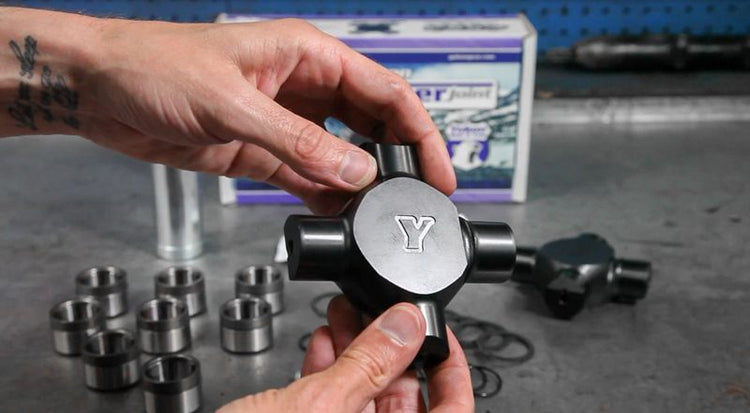
How It Works: U-Joints
The u-joint plays a critical role in the drivetrain. They are one of those parts that are simple in their task and therefore often taken for granted. Whether in the front axle or on a driveshaft, the u-joint’s capabilities need to be understood. Doing The Job U-joints or universal joints join spinning components together while allowing them to move up and down in coordination with the vehicle’s suspension. The cross-shaped units join driveshafts to transmissions/transfer cases, differentials, and other sections of driveshafts. They also connect two-piece front axles. Types Of U-Joints There are two types of u-joints; sealed greaseable and non-greaseable. There is a long-standing debate over which style of u-joint is stronger. But independent lab testing done by various entities have proven neither style has a clear, real world advantage. You will see a four-digit number accompanying many u-joint descriptions. The numbers, 1310, 1350, 1410, 1550, and others, refer to the series, or size, of the u-joint which is determined by its dimensions. Lubrication Importance Putting all the specs aside, lubrication shortcomings are the most common cause of u-joint failure. Not keeping up with general maintenance in a greaseable unit or contamination of the lubricant in a sealed, non-greaseable joint. Other culprits include plain old wear and improper installation or poor build quality, i.e. the use of poor-quality grease or using too little grease, in a non-greaseable u-joint. Torque Multiplication When talking about strength and durability of front axle u-joints one must remember there is a torque multiplication factor at work here. It comes into play when the front driveline experiences angles and at a maximum angle of 40 degrees 30% more torque can be projected onto the u-joint. The multiplication is nominal up to 15 degrees and then the curve progresses from there. This means that a u-joint that is working near its yield point can deform if you’re crawling or bogging and putting a max load on the driveline via angularity. The workaround is to keep your wheels as straight as possible during these high load situations. Ring Clips FTW If a u-joint is being pushed to failure there are ways to increase its survivability envelope or at the very least prolong its life momentarily. It’s all about rings and clips. Using full circle snap rings in place of the traditional c-clips will resist distortion of the joint as the yoke ears begin to thrust the caps out of place. The c-clips usually used to secure the caps cannot resist the side forces very well but the full circle clips will do a better job and therefore help delay u-joint failure. The full circle clips must be installed at assembly and OE axles may require some clearancing in the yoke to allow fitment. Many aftermarket axles have grooving large enough to accommodate full circle clips. Weak Links There are two primary failure points in conventional OE-spec u-joints – the cross and the caps. The failure scenario plays out at the caps. Typically, in OE-style axles the yokes will be stressed to distortion and as they spread outward the caps are also affected. The caps move and eventually destroy the needle bearings and often become dislodged from the yoke and fall off. If the caps somehow survive the cross itself can suffer the effects of the stress by distorting and failing. Yukon Super Joints Yukon Super Joints offer an upgrade in strength and durability over factory u-joints and excel in off-road applications. Designed for Dana 60, Dana 44, Dana 30, and GM 8.5” differentials, Yukon Super Joints feature a 4340 chromoly cross and the caps are made from 4140 steel. The caps are formed from slightly softer steel to isolate the wear to the caps not the cross because it’s a lot more convenient and less expensive to replace the caps. A diamond-like coating offers outstanding wear resistance on the trunnions and corrosive resistance for the entire cross. The end of each trunnion is home to a reservoir for the grease. You’ll notice the trunnion is larger in circumference compared to conventional u-joints. This is the result of eliminating the needle bearings entirely, replacing them with a bushing setup. These joints were never designed for daily drivers. They require fanatical maintenance, greasing each of the eight caps after each long trail run. We do not recommend installing them in a vehicle that does not have locking hubs… this is NOT one of those products you can ‘get by’ with on the street. If they lose their lubrication properties the joints can gall and lock up the vehicle’s steering. They are intended for competition vehicles or dedicated off-roaders that strictly run the trails. Along with the Super Joint(s) and caps you’ll receive an installation manual, sticker, grease gun, high-quality anti-seize grease, and associated small parts like O-rings, zerk fittings, and a set of full-circle snap ring clips. Yokes and u-joints are critical links in the drivetrain’s chain of performance. Ensuring your yokes and u-joints are strong enough and properly maintained will keep you and your ride running smoothly for years to come. Shop U-Joints
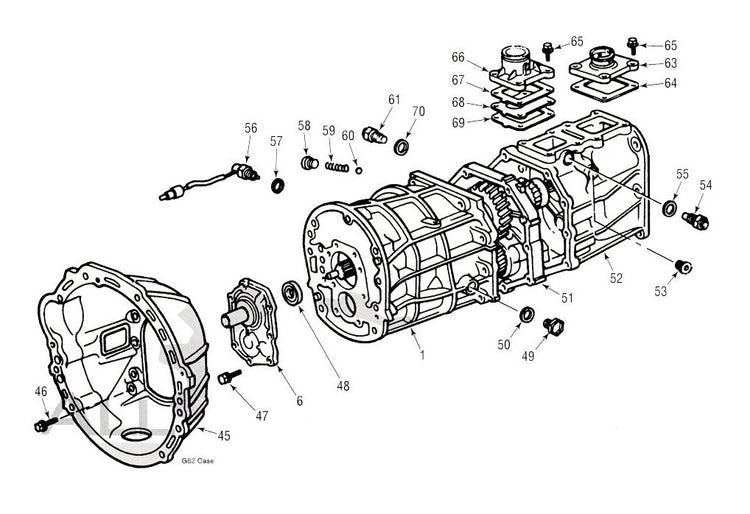
Jeep Wrangler Transmission Spotter’s Guide
AX-15 – 5-Speed Manual Jeep Wrangler: 1988.5 - 1999 with 4.0-liter Inline 6 Factoids: Replaced weak Peugeot BA10 gearbox Related to Toyota Supra Turbo R154 manual Best 5-speed ever installed in a Wrangler Spotting Tips: All-aluminum case & mid-plate, generous ribbing Only mounts to a six-cylinder engine 10 spline input shaft 23 spline output shaft Length: 16 1/2” Spline Stick-out: 7 1/8” Gear Ratios: 1st 3.83, 2nd 2.33, 3rd 1.44, 4th 1.00, 5th 0.79 AX-5 – 5-Speed Manual Jeep Wrangler: 1984 - 2006 XJ, YJ, TJ with 2.5-liter Inline 4 Factoids: Failure prone 5th gear, poor synchronizers, throwout bearing leaks (pre ’94) AX-5 variants include Toyota G52, W58, and R151 Spotting Tips: All-aluminum case, cast iron mid-plate Looks like AX-15 so be wary Only mounts to a four-cylinder engine 14 spline input shaft 21 spline output shaft Length: 15 5/8” Spline Stick-out: 7 1/2” Gear Ratios: 1st 3.92, 2nd 2.33, 3rd 1.44, 4th 1.00, 5th 0.85 NV3550 – 5-Speed Manual Jeep Wrangler: 2000 - 2004 Wrangler with 4.0-liter Inline 6 Factoids: Replaced AX-15 Compatible with 23 spline version of NP231 transfer case Spotting Tips: All-aluminum case 10 spline input shaft 23 spline output shaft Length: 16 3/4” Gear Ratios: 1st 4.01, 2nd 2.32, 3rd 1.40, 4th 1.00, 5th 0.78 NSG370 – 6-Speed Manual Jeep Wrangler: 2005-up Wrangler, 2004-up Wrangler Rubicon Factoids: Replaced NV3550 Compatible with 4.0-liter I6 and 3.8-liter V6 Spotting Tips: All-aluminum case with extensive ribbing 10 spline input shaft 23 spline output shaft Length: 23 1/2” w Inline 6 bellhousing Length: 24 3/4” w/ 3.7-L V6 bellhousing Gear Ratios: 1st 4.46, 2nd 2.61. 3rd 1.72, 4th 1.25, 5th 1.00, 6th 0.84 Shop Re-Manufactured Transmissions
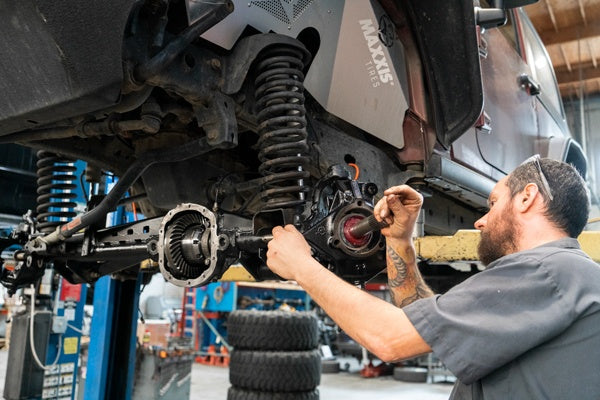
Top 10 Axle Seal Installation Tips
As with many automotive operations, the complexity of a task is not always representative of its importance. Take axle seal installation… a pretty straightforward affair but get it wrong and your diff is doomed. The seal will leak and ultimately lead to gear failure. To avoid this scenario, we have compiled 10 installation tips that will ensure you do the job right. There are many different types of axle seals. For our purposes we will be referring to the popular dynamic radial seal. These seals typically feature a mild carbon steel shell. In cases where corrosion is a concern the shell can be formed from stainless steel. In most cases, the seal will be outfitted with a garter spring to keep the seal lip tight against the rotating seal surface. Garter springs are made of spring steel wire and in some cases stainless steel and can be locked into place or merely wedged in place so special attention should be paid to ensure proper seating during installation. The inside of the seal is called the lip and it is typically made of some type of rubberized material. The lip can look different from one seal to another with some featuring a stepped design or more than one lip. The shell has a bore seal bumper on its oil side that is made from a softer material to provide a pliable seal. 1 - Right Tool For The Job A seal installation tool that’s designed for the particular seal you’re working with is preferred. Seal installation kits from your local parts store or online tools source are inexpensive, long lasting, and effective. In lieu of that, a socket or bearing race will work in a pinch. The Yukon front inner axle seal installation tool (pictured) works with Dana 30, 44, and 60 front differentials. 2 - Inspect & Detect - Shaft Inspect the shaft where the seal will ride. Light imperfections in the finish can be polished with crocus cloth or emery cloth. If more substantial defects like deep scratches, pitting, or scoring are present you may have to remedy with a new shaft or install a Speedi Sleeve. If the shaft is blemish free, clean it well to remove any residual grit. 3 - Inspect & Detect - Bore Take the same approach with the bore. Look for the usual scratches and pitting but also check for roundness. There should be a chamfered edge around the bore to aid in seal installation. A light chamfer can be added, if needed, using a fine-tooth file. Beyond that, clean the area of grit and excess oil. 4 - Seal The Deal It is wise to use a sealant like an RVT, on the outside diameter of the seal shell to ensure no fluid will be able to seep around the seal once it’s installed. Note that many seals are made with a coating on their outside diameter to assist in this. 5 - Drive It Square Be deliberate and ensure you drive the seal in place squarely. Don’t allow the seal to go in the bore crooked and possibly damage the seal and/or the seal bore. Keep the seal square and install it until it’s flush with the housing or against its stop. It would be wise to note the position of the original seal prior to its removal. 6 - Face Forward Install the seal such that the garter spring is facing inward, toward the fluids you intend to seal in. 7 - Spring Stability In some installations the garter spring can pop off during the process. To avoid this simply apply the backside of the seal with grease (or Vaseline in a pinch) to encourage the spring to stay in place. 8 - Lip Protection When sliding seal over the shaft be sure to protect the lip or leading edge. This can be achieved with special sleeves over splines, using guide plates, or simply using smooth tape… or being very careful. An extension screwed onto the stud of an axle shaft, for example, can provide the control and support needed to complete the installation without having to rest on the shaft. 9 - Lip Lubrication Use grease or gear oil, to lubricate the seal lip and/or the shaft to facilitate easy installation. 10 - Vent Clearance Check that the axle vents are free and clear of any gritty buildup. Clogged vents can lead to excessive housing pressure that may speed the wear of the seal and encourage oil blowby around the seal. These tips, compiled from Randy Lyman’s book, “Differentials Identification, Restoration & Repair”, provide both the technical information and the proper frame of mind to ensure a trouble-free seal install. Happy wrenching.


